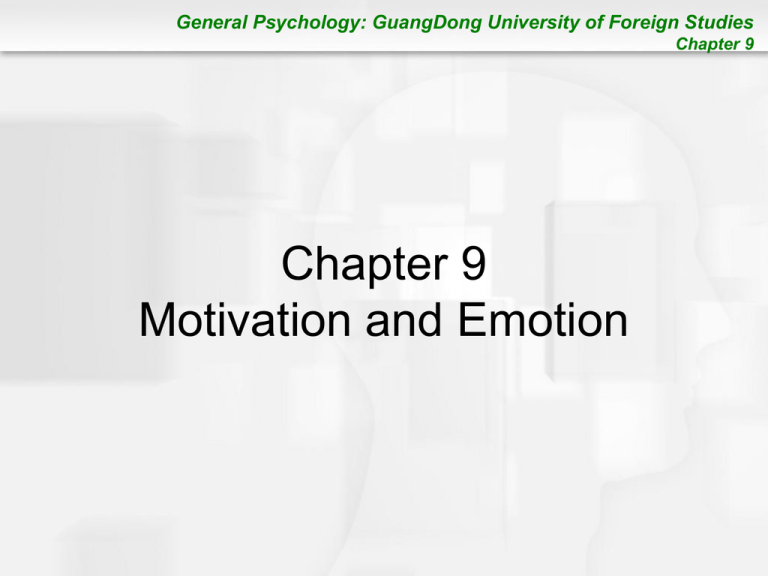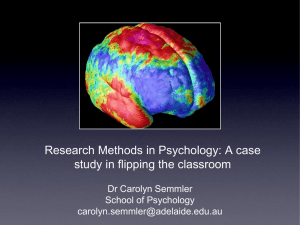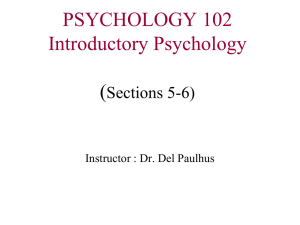
General Psychology: GuangDong University of Foreign Studies
Chapter 9
Chapter 9
Motivation and Emotion
General Psychology: GuangDong University of Foreign Studies
Chapter 9
Motivation
Dynamics of behavior that initiate, sustain, direct, and
terminate actions
General Psychology: GuangDong University of Foreign Studies
Chapter 9
A Model of Motivational Activities
• Model of how motivated activities work
• Need: Internal deficiency; causes
• Drive: Energized motivational state (e.g., hunger,
thirst); activates a…
• Response: Action or series of actions designed to
attain a…
• Goal: Target of motivated behavior
• Incentive Value: Goal’s appeal beyond its ability to fill a
need
General Psychology: GuangDong University of Foreign Studies
Chapter 9
Types of Motives
• Primary Motive: Innate (inborn) motives based on
biological needs we must meet to survive
• Stimulus Motive: Innate needs for stimulation and
information
• Secondary Motive: Based on learned needs, drives, and
goals
General Psychology: GuangDong University of Foreign Studies
Chapter 9
Hunger: Big Mac Attack?
• Homeostasis: Body equilibrium; balance
• Hypothalamus: Brain structure; regulates many aspects
of motivation and emotion, including hunger, thirst, and
sexual behavior
• Lateral Hypothalamus: If turned on, an animal will begin
eating; if destroyed, an animal will never eat again!
• Ventromedial Hypothalamus: Stops eating behavior
General Psychology: GuangDong University of Foreign Studies
Figure 9.2
FIGURE 9.2 In Walter Cannon’s early study of hunger, a simple apparatus was used to
simultaneously record hunger pangs and stomach contractions.
Chapter 9
General Psychology: GuangDong University of Foreign Studies
Figure 9.3
Chapter 9
FIGURE 9.3 Location of the hypothalamus in the human brain.
General Psychology: GuangDong University of Foreign Studies
Figure 9.4
Chapter 9
FIGURE 9.4 This is a cross section through the middle of the brain (viewed from the front of the
brain). Indicated areas of the hypothalamus are associated with hunger and the regulation of
body weight.
General Psychology: GuangDong University of Foreign Studies
Chapter 9
More on Eating Behavior (Hungry Yet?)
• Neuropeptide Y (NPY): Substance in the brain that
initiates eating
• Glucagon-like Peptide 1 (GLP-1): Substance in brain that
terminates eating
• Set Point: Proportion of body fat that is maintained by
changes in hunger and eating; point where weight stays
the same when you make no effort to gain or lose weight
General Psychology: GuangDong University of Foreign Studies
Chapter 9
The Final Word on Eating Behavior
• Leptin: Substance released by fat cells that inhibits
eating
• External Eating Cues: External stimuli that tend to
encourage hunger or elicit eating; these cues may cause
you to eat even if you are stuffed (like Homer Simpson,
who eats whatever he sees!)
General Psychology: GuangDong University of Foreign Studies
Chapter 9
Behavioral Dieting
• Weight reduction based on changing exercise and eating
habits and not on temporary self-starvation
• Some keys
– Start with a complete physical
– Exercise
– Be committed to weight loss
General Psychology: GuangDong University of Foreign Studies
Chapter 9
Behavioral Dieting (cont'd)
• Observe yourself, keep an eating diary, and keep a chart
of daily progress.
• Eat based on hunger, not on taste or learned habits that
tell you to always clean your plate.
• Avoid snacks.
• Reward yourself if you change eating habits and punish
yourself if you do not.
General Psychology: GuangDong University of Foreign Studies
Chapter 9
Taste
• Taste Aversion: Active dislike for a particular food
– VERY difficult to overcome
General Psychology: GuangDong University of Foreign Studies
Chapter 9
Eating Disorders: Anorexia Nervosa
• Active self-starvation or sustained loss of appetite that
seems to have psychological origins
– Control issues seem to be involved
– Very difficult to effectively treat
– Affects adolescent females overwhelmingly
General Psychology: GuangDong University of Foreign Studies
Figure 9.6
Chapter 9
FIGURE 9.6 Women with abnormal eating habits were asked to rate their body shape on a
scale similar to the one you see here. As a group, they chose ideal
figure is much thinner than what they thought their current weights were. (Most women say they
want to be thinner than they currently are, but to a lesser degree than women with eating
problems.) Notice that women with eating problems chose an ideal weight that was even thinner
than what they thought men prefer. This is not typical of most women. Only women with eating
problems wanted to be thinner than what they thought men find attractive
General Psychology: GuangDong University of Foreign Studies
Chapter 9
Eating Disorders: Bulimia Nervosa
(Binge-Purge Syndrome)
• Excessive eating usually followed by self-induced
vomiting and/or taking laxatives
– Difficult to treat
– Prozac approved by FDA to treat bulimia nervosa
– Affects females overwhelmingly
General Psychology: GuangDong University of Foreign Studies
Chapter 9
Causes of Anorexia Nervosa and
Bulimia Nervosa
• Anorectics and bulimics have exaggerated fears of
becoming fat; they think they are fat when the opposite is
true!
• Bulimics are obsessed with food and weight; anorectics
with perfect control.
• Anorectics will often be put on a “weight-gain” diet to
restore weight.
General Psychology: GuangDong University of Foreign Studies
Chapter 9
Thirst and Pain
• Extracellular Thirst: When water is lost from fluids
surrounding the cells of the body
• Intracellular Thirst: When fluid is drawn out of cells
because of increased concentration of salts and minerals
outside the cell
– Best satisfied by drinking water
• Pain Avoidance: An episodic drive
– Distinct episodes when bodily damage takes place or
is about to occur
General Psychology: GuangDong University of Foreign Studies
Chapter 9
Sex Drive
• Estrus: Changes in animals that create a desire for sex;
females in heat
• Estrogen: A female sex hormone
• Androgens: Male hormones
General Psychology: GuangDong University of Foreign Studies
Figure 9.7
Chapter 9
FIGURE 9.7 These graphs show the frequency of sexual intercourse for American adults. To
generalize, about one third of the people surveyed have sex twice a week or more, one third a
few times a month, and one third a few times a year or not at all. The overall average is about
once a week
General Psychology: GuangDong University of Foreign Studies
Chapter 9
Sexual Behavior and Orientation
• Erogenous Zones: Areas of the body that produce
pleasure and/or provoke erotic desires (genitals, breasts,
etc.)
• Sexual Orientation: Degree of emotional and erotic
attraction to members of the same sex, opposite sex, or
both sexes
– Heterosexual: Attracted romantically and erotically to
the opposite sex
– Homosexual: Attracted romantically and erotically to
the same sex
– Bisexual: Attracted romantically and erotically to both
sexes
General Psychology: GuangDong University of Foreign Studies
Chapter 9
Human Sexual Response: Masters and Johnson
• Sexual response can be divided into four phases that
occur in the following order:
– Excitement: Initial signs of sexual arousal
– Plateau: Physical arousal intensifies
– Orgasm: Climax and release of sexual tension
– Resolution: Return to lower levels of sexual tension
and arousal
General Psychology: GuangDong University of Foreign Studies
Chapter 9
Stimulus Drives
• Reflect needs for information, exploration, manipulation,
and sensory input
• Sensation Seeking: Trait of people who prefer high levels
of stimulation (e.g., the contestants on “Eco-Challenge”
and “Fear Factor”)
• Yerkes-Dodson Law: If a task is simple, it is best for
arousal to be high; if it is complex, lower levels of arousal
provide for the best performance
General Psychology: GuangDong University of Foreign Studies
Figure 9.11
Chapter 9
FIGURE 9.11 (a) The general relationship between arousal and efficiency can be described by
an inverted U curve. The optimal level of arousal or motivation is higher for a simple task (b) than
for a complex task (c).
General Psychology: GuangDong University of Foreign Studies
Chapter 9
How to Cope With Test Anxiety
•
•
•
•
Preparation
Relaxation
Rehearsal
Restructuring thoughts
General Psychology: GuangDong University of Foreign Studies
Chapter 9
Circadian Rhythms
• Cyclical changes in bodily functions and arousal levels
that vary on a 24-hour schedule
• Preadaptation: Gradual matching of sleep-waking cycles
to a new time schedule before an anticipated circadian
rhythm change (e.g., trying to adjust to new time zone to
avoid jet lag)
General Psychology: GuangDong University of Foreign Studies
Figure 9.12
Chapter 9
FIGURE 9.12 Core body temperature follows a circadian rhythm. Most people reach a low point
2 to 3 hours before the time they normally wake u
Page It’s no wonder that both the Chernobyl and Three-Mile Island nuclear power plant accidents
occurred around 4 A.M. Rapid travel to a different time zone, shift work, depression, and illness
can disrupt the body’s core rhythm, with disturbing effects
General Psychology: GuangDong University of Foreign Studies
Figure 9.13
Chapter 9
FIGURE 9.13 Time required to adjust to air travel across six time zones. The average time to
resynchronize was shorter for westbound travel than for eastbound flights.
General Psychology: GuangDong University of Foreign Studies
Chapter 9
Learned Motives
• Social Motives: Acquired by growing up in a particular
society or culture
• Need for Achievement (nAch): Desire to meet some
internal standard of excellence
• Need for Power: Desire to have impact or control over
others
General Psychology: GuangDong University of Foreign Studies
Chapter 9
Abraham Maslow and Needs
• Hierarchy of Human Needs: Maslow’s ordering of needs
based on presumed strength or potency; some needs
are more powerful than others and thus will influence
your behavior to a greater degree
• Basic Needs: First four levels of needs in Maslow’s
hierarchy
– Lower needs tend to be more potent than higher
needs
• Growth Needs: Higher-level needs associated with selfactualization
• Meta-Needs: Needs associated with impulses for selfactualization
General Psychology: GuangDong University of Foreign Studies
Figure 9.14
Chapter 9
FIGURE 9.14 Maslow believed that lower needs in the hierarchy are dominant. Basic needs must
be satisfied before growth motives are fully expressed. Desires for selfactualization are reflected
in various metaneeds (see text).
General Psychology: GuangDong University of Foreign Studies
Chapter 9
Types of Motivation
• Intrinsic Motivation: Motivation coming from within, not
from external rewards; based on personal enjoyment of
a task
• Extrinsic Motivation: Based on obvious external rewards,
obligations, or similar factors (e.g., pay, grades)
General Psychology: GuangDong University of Foreign Studies
Chapter 9
Emotions
• State characterized by physiological arousal and
changes in facial expressions, gestures, posture, and
subjective feelings
• Adaptive Behaviors: Aid our attempts to survive and
adjust to changing conditions
• Physiological Changes: Include heart rate, blood
pressure, perspiration, and other involuntary bodily
responses
• Adrenaline: Hormone produced by adrenal glands that
arouses the body
• Emotional Expression: Outward signs of what a person
is feeling
• Emotional Feelings: Private emotional experience
General Psychology: GuangDong University of Foreign Studies
Chapter 9
Plutchik’s First Four Primary Emotions
• Most basic emotions are:
– Fear
– Surprise
– Sadness
– Disgust
General Psychology: GuangDong University of Foreign Studies
Chapter 9
Plutchik’s Last Four Primary Emotions (cont'd)
–
–
–
–
Anger
Anticipation
Joy
Acceptance
General Psychology: GuangDong University of Foreign Studies
Figure 9.15
Chapter 9
FIGURE 9.15 Primary and mixed emotions. In Robert Plutchik’s model, there are eight primary
emotions, as listed in the inner areas. Adjacent emotions may combine to give the emotions
listed around the perimeter. Mixtures involving more widely separated emotions are also possible.
For example, fear plus anticipation produces anxiety.
General Psychology: GuangDong University of Foreign Studies
Figure 9.16
Chapter 9
FIGURE 9.16 Folklore holds that people who work or attend school on a weekly schedule
experience their lowest moods on “Blue Monday.” Actually, moods tend to be generally lower for
most weekdays than they are on weekends. The graph shown here plots the average daily
moods of a group of college students over a 5-week period. As you can see, many people find
that their moods rise and fall on a 7-day cycle. For most students, a low point tends to occur
around Monday or Tuesday and a peak on Friday or Saturday.
General Psychology: GuangDong University of Foreign Studies
Chapter 9
Brain and Emotion
• Autonomic Nervous System (ANS): Neural system that
connects brain with internal organs and glands
• Sympathetic Branch: Part of ANS that activates body for
emergency action
• Parasympathetic Branch: Part of ANS that quiets body
and conserves energy
– Parasympathetic Rebound: Overreaction to intense
emotion
General Psychology: GuangDong University of Foreign Studies
Chapter 9
Lie Detectors
• Polygraph: Device that records heart rate, blood
pressure, respiration, and galvanic skin response (GSR);
lie detector
• GSR: Measures sweating
• Irrelevant Questions: Neutral, emotional questions in a
polygraph test
• Relevant Questions: Questions to which only someone
guilty should react by becoming anxious or emotional
• Control Questions: Questions that almost always
provoke anxiety in a polygraph (e.g. “Have you ever
taken any office supplies?”)
General Psychology: GuangDong University of Foreign Studies
Chapter 9
Body Language (Kinesics)
• Study of communication through body movement,
posture, gestures, and facial expressions
• Facial Blends: Mix of two or more basic expressions
General Psychology: GuangDong University of Foreign Studies
Chapter 9
Three Types of Facial Expressions
• Pleasantness-Unpleasantness: Degree to which a
person is experiencing pleasure or displeasure
• Attention-Rejection: Degree of attention given to a
person or object
• Activation: Degree of arousal a person is experiencing
General Psychology: GuangDong University of Foreign Studies
Figure 9.19
Chapter 9
FIGURE 9.19 When shown groups of simplified faces (without labels), the angry and scheming
faces “jumped out” at people faster than sad, happy, or neutral faces. An ability to rapidly detect
threatening expressions probably helped our ancestors survive.
General Psychology: GuangDong University of Foreign Studies
Chapter 9
Theories of Emotion
• James-Lange Theory: Emotional feelings follow bodily
arousal and come from awareness of such arousal.
• Cannon-Bard Theory: The thalamus (in brain) causes
emotional feelings and bodily arousal to occur at the
same time.
• Schachter’s Cognitive Theory: Emotions occur when a
label is applied to general physical arousal.
• Attribution: Mental process of assigning causes to events;
attributing arousal to a certain source.
• Facial Feedback Hypothesis: Sensations from facial
expressions and help define what emotion someone
feels.
General Psychology: GuangDong University of Foreign Studies
Figure 9.21
Chapter 9
FIGURE 9.21 Theories of emotion.
General Psychology: GuangDong University of Foreign Studies
Chapter 9
A Modern View of Emotion
• Emotional Appraisal: Evaluating personal meaning of a
stimulus
• Emotional Intelligence: Combination of skills, including
empathy, self-control, self-awareness, sensitivity to
feelings of others, persistence, and self-motivation
General Psychology: GuangDong University of Foreign Studies
Figure 9.23
Chapter 9
FIGURE 9.23 A contemporary model of emotion.
General Psychology: GuangDong University of Foreign Studies
Chapter 9
Happiness
• Subjective Well-Being (SWB): When people are satisfied
with their lives, have frequent positive emotions, and
have relatively few negative emotions
• Are these factors related to happiness?
– Wealth: No relation
– Education: Not really
– Marriage: Not really
– Religion: Minimally
General Psychology: GuangDong University of Foreign Studies
Chapter 9
Happiness Factors (cont'd)
–
–
–
–
Aging: Happiness does not decline with age.
Sex: Men and women do not differ in happiness.
Work: No.
Personality: If you have a “sunny disposition,” you are
more likely to be happy.







